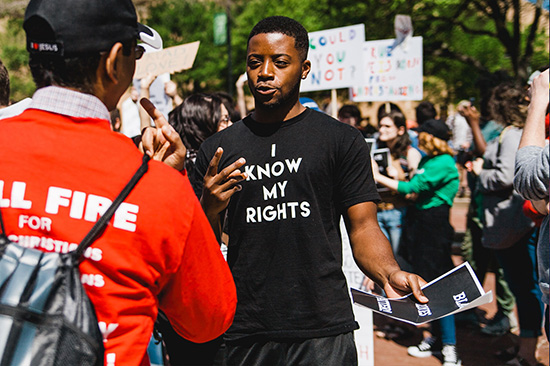U.S. Current Trend: University Restrictions
Narrowing Space for Campus Protests
U.S. university campuses have long been associated with student protests and free expression. In recent years, there has been a revitalization of this tradition with many campuses seeing a surge in student demonstrations, whether this has been related to the black lives matter movement, protesting the Trump administration’s immigration policies, or other issues.

U.S. university campuses have long been associated with student protests and free expression. This tradition has revitalized in recent years, with many campuses experiencing a surge in student demonstrations on topics ranging from the Black Lives Matter movement to protests against the Trump administration’s immigration policies.
In a charged political environment, campus demonstrations sometimes result in confrontations between protesters, speakers, counter-protesters, and university administrators. A number of new regulations or laws have been passed or are being considered to regulate campus protests. Some of these new rules help clarify demonstrators’ rights, but others risk chilling participation in campus protests. For example, states, such as North Carolina and Alabama, have enacted laws since 2017 that require disciplinary sanctions against those who interfere or disrupt the “rights” of others to engage in or listen to “protected” expressive activity. As highlighted in ICNL’s U.S. protest law tracker, in 2019 similar bills were introduced in Illinois, Michigan, Minnesota, Missouri, South Carolina, and Texas. These introduced bills generally include mandatory suspension or expulsion for a student protestor after the second offense.
Bills requiring mandatory sanctions against student protesters who disrupt speakers on campus have been promoted in the name of protecting free speech by groups like the Goldwater Institute. Other groups, such as PEN America and the Foundation for Individual Rights in Education (FIRE), have criticized mandatory minimum sanctions, claiming that they do not strike the correct balance between the rights of students and the rights of speakers and can be abused to punish protesters unfairly. Fearful of mandatory punishments, students and others on campus may simply decide not to express their opinions.
Further, several of the bills incentivize universities to preemptively crack down on student demonstrations. For example, in Illinois a bill introduced in 2019 created a cause of action against the university by a person whose “expressive rights are violated” on campus. Presumably, a person could bring legal action against the university even if these “expressive rights” were violated not by the university, but by student protesters. This creates an incentive for university administrators to overzealously police demonstrators to avoid potential liability. Many of these bills also have provisions that undercut the university’s ability to take public policy stances, such as participating in a divestment campaign, by requiring that universities strive “to maintain an official position of neutrality on matters of public concern”.
It is not just states that have enacted laws targeting campus protests, but also University governing bodies.For example, in October 2017, the University of Wisconsin’s Board of Regents approved a resolution to suspend any student involved twice in “violent or other disorderly misconduct that materially and substantially disrupted the free expression of others.” A third such incident would lead to expulsion.
Universities have also limited permitted locations for campus protests. After a sit-in at Ohio University, in which student protesters demanded that their university become a sanctuary campus, the administration adopted a new policy in September 2017 that banned all demonstrations and sit-ins in university buildings. This is just one version of a “free speech zones” that limit student protests to (frequently very) restricted areas on campus. FIRE estimates that in 2017 one in ten universities had free speech zone policies.
Finally, the federal government has also become more involved in regulating campus speech. In March 2019, President Trump issued an Executive Order that ties federal funding of universities to these institutions taking appropriate steps to “promote free inquiry”. This includes public universities following the First Amendment and private universities following their stated institutional policies regarding free speech. While it is not yet clear how federal agencies will interpret this Executive Order, some organizations are concerned it could lead to politicized interference with university governance in the future and government monitoring of the political activity of students and faculty.
Although often couched in the language of promoting free speech, these new laws and rules regulating campus speech too often threaten to chill students’ right to express their views and America’s long tradition of student protests.
June 2019
For an analysis of some of the most concerning provisions of U.S. campus speech bills, see ICNL’s Legislative Briefer “Campus Speech Bills and the Right to Protest” (April 2018).
For more information contact: Nick Robinson at nrobinson@icnl.org
To subscribe to US Program email updates, click here.
Sign up for our newsletters
Sign up